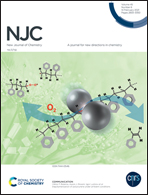Engineering Z-system hybrids of 0D/2D F-TiO2 quantum dots/g-C3N4 heterostructures through chemical bonds with enhanced visible-light photocatalytic performance
Abstract
Constructing a direct Z-scheme system for photocatalysts is a promising strategy to enhance photocatalytic redox performance owing to its effective charge transfer; however, building a reasonable interfacial charge transfer bridge for charge selective recombination is still a challenge. Herein, a F-doped TiO2 quantum dot/g-C3N4 nanosheet Z-scheme photocatalyst is synthesized via a facile method of fluorine-containing solvothermal treatment. In this Z-scheme structure, F-TiO2 quantum dots (QDs, 3–7 nm) are bridged with g-C3N4 nanosheets through C–O covalent bonds. Thus, the oxidizability and reducibility of the composite photocatalyst and the interfacial charge transfer ability are greatly improved. Meanwhile, the TiO2 quantum dots provide more active sites and enhance the light harvesting, which are both beneficial for the photocatalytic reaction process. In this designed catalyst, the C–O covalent bond, as a chemical group bridge, provides an effective pathway for charge transfer and selective recombination, which greatly enhances the utilization of photogenerated electrons and holes. As a result, the FT/CNS-1-2 photocatalyst shows the highest photocatalytic activity for photocatalytic rhodamine B (RhB) decomposition, Cr(VI) reduction and phenol decomposition under visible light irradiation, which are about 17.1/4, 16/5.3 and 23.5/4.4 times higher than those of pure F-TiO2/g-C3N4, respectively. The excellent photocatalytic activity is mainly ascribed to the Z-scheme charge transfer model, which greatly enhanced the separation and transfer of charge carriers. In addition, the trapping experiments found that ˙O2− and ˙OH are the dominant active species in the photocatalytic process. This study of the chemically bonded Z-scheme F-TiO2/g-C3N4 photocatalyst provides ideas for the fabrication of such TiO2 QD based materials and a Z-scheme system for effective change transfer in photocatalysis processes.



 Please wait while we load your content...
Please wait while we load your content...